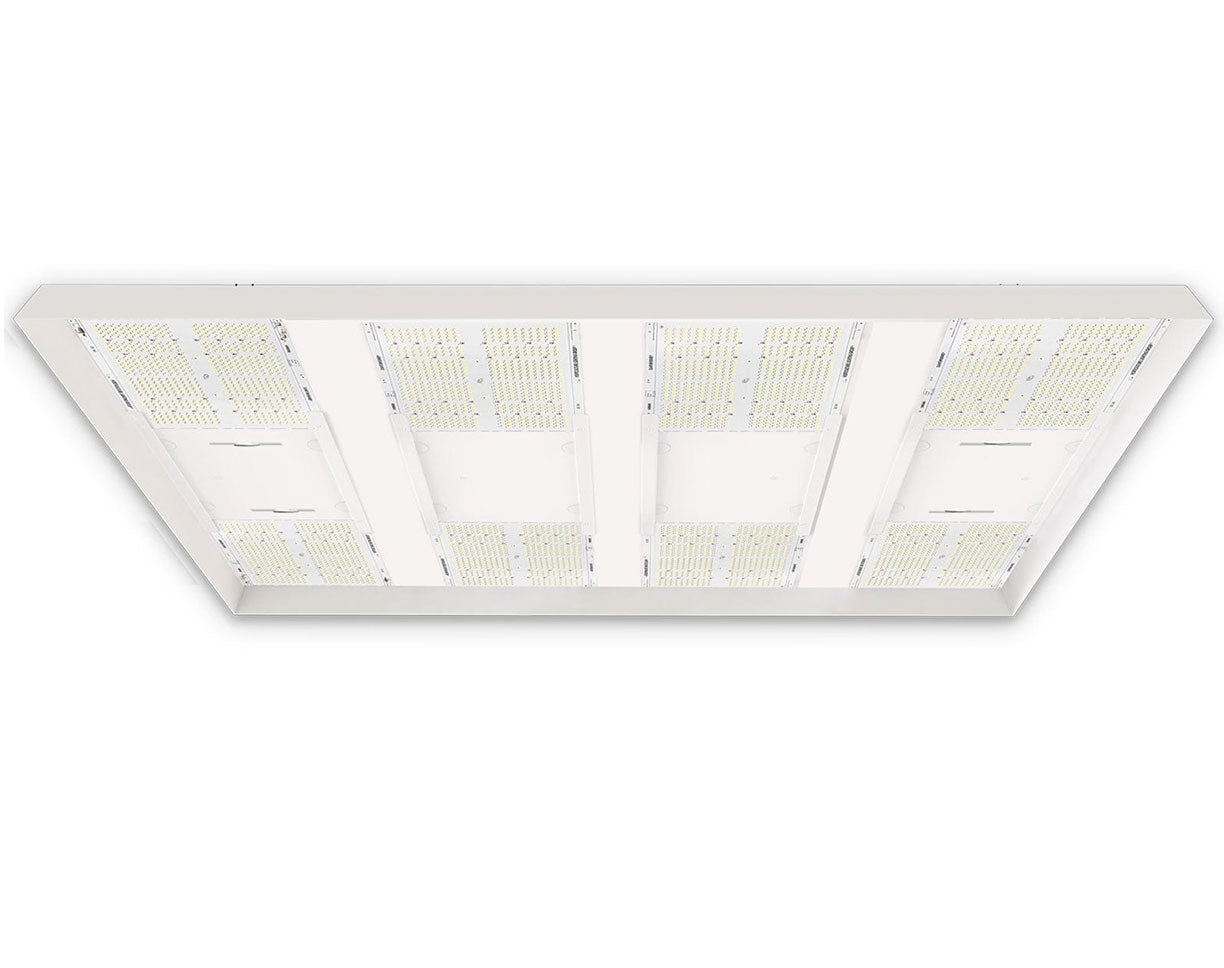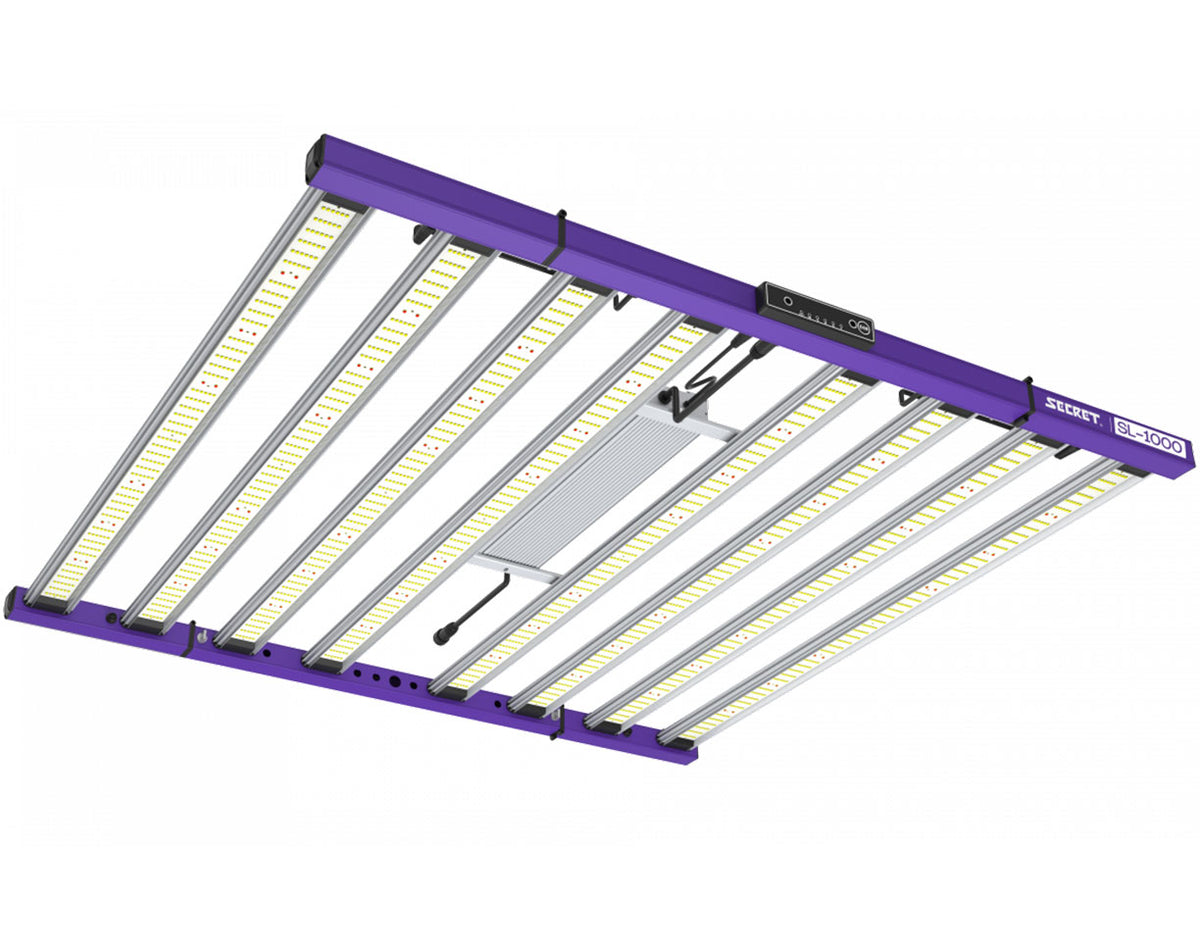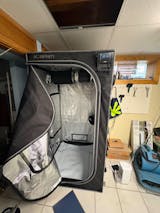Yes, we know you’ve seen the same old list… but it’s a new day and new tech. These are our picks for best-rated LED grow lights based on performance, spectrum control, and true value. Which one’s best? That depends on your grow space, technique, and budget. Read on to find your perfect fit.
Top 4 Best 1000W LED Grow Lights
💡 For mobile users, switch to landscape mode📱🔄 to explore the complete table.
| Model |
Power |
PPF • PPE |
Spectrum Control |
Footprint |
Best For |
| GrowPros DraGrow 1350 W |
1350 |
≈ 3705 µmol/s;
3.1 µmol/J |
Channel 1: UVA + Deep Blue
Channel 2: Full Spectrum + IR |
4 × 6 ft (flower)
5 × 7 ft (veg) |
Vertical rigs needing spectrum control |
| HLG Scorpion Ultima Diablo X |
Up to 1500 |
≈ 4615 µmol/s;
3.07 µmol/J |
Dual-zone (white + deep red), reflectors |
4 × 4 to 5 × 5 ft |
Max. canopy penetration in tents/racks |
| SecretLED SL-1000 |
1000 |
2900 µmol/s;
2.9 µmol/J |
Full white + 660 nm red,
onboard dimmer + external control |
4 × 4 to 5 × 5 ft |
Open rooms, benches, racks, grow tents |
| Grand Master Tarantula Explorer |
Up to 1440 |
≈ 3845 µmol/s;
2.67 µmol/J |
2-channel, up to 12 custom spectrums incl. 730 nm |
5 × 5 ft |
Commercial builds wanting rugged, waterproof setup |
Factors to Consider When Buying a 1000-Watt LED Plant Light
Actual Wattage
Modern fixtures often exceed the “1000W” label—HLG Diablo X and DraGrow draw 1350–1500 W for higher output and deeper penetration. Dual-zone or manual dimmers optimize energy use across growth stages.
Spectrum
-
White LEDs vs. Multi-Band Spectrums
White-spectrum LEDs (e.g., HLG Scorpion) offer natural visibility and full-cycle support. Multi-band fixtures (e.g., Tarantula Explorer) give precise control with UV, Far-Red, and multiple white bands.
-
Customizable Spectrum
Dual-channel or manual dimming lets you tailor veg and bloom spectrums smoothly, minimizing plant stress with app or controller integrations.
Light Output
Look for transparent PPF (µmol/s) and efficacy (µmol/J) ratings. Top fixtures now produce 3700–4600 µmol/s, outperforming 1000 W HPS in efficiency and canopy reach.
Canopy Penetration
Reflectors and optimized diode layouts (found in HLG’s Scorpion line) drive photons deeper into dense canopies. Evaluate uniform PPFD across hanging heights, not just center intensity.
Coverage Area
Expect optimized footprints from 4×4 ft to 5×5 ft. DraGrow’s 4×6 ft suits rack-style grows; compact 5×5 ft models fit tents and rooms with tight beam angles.
Top 4 High-Output LED Grow Lights for 2025
In today's saturated market, most “top picks” are chosen based on affiliate commissions, not performance. Here's an honest evaluation of four premium LED fixtures built to deliver real light, not just clicks.In today's saturated market, most “top picks” are chosen based on affiliate commissions, not performance. Here's an honest evaluation of four premium LED fixtures built to deliver real light, not just clicks.
1. GrowPros DraGrow 1350 W – Full Spectrum + UV/FR
A powerhouse for both commercial and home growers. The ultra‑slim 12‑bar design excels in vertical and rack systems, enhancing airflow and light distribution. Two manual dimmers make switching between veg and bloom effortless.A powerhouse for both commercial and home growers. The ultra‑slim 12‑bar design excels in vertical and rack systems, enhancing airflow and light distribution. Two manual dimmers make switching between veg and bloom effortless.
Highlights:
- Massive output (PPF ≈ 3847 µmol/s) with top-tier efficiency (3.1 µmol/J)
- Full spectrum including UV & Far‑Red
- Plug‑and‑play installation, TrolMaster‑ready, 5‑year warranty
Considerations:
- Large footprint requires solid mounting support
- Manual dimmers. No wireless control (unless you add one)
Get more info here
2. HLG Scorpion Ultima Diablo X – Maximum Output & Penetration
The “X” variant in HLG’s flagship Diablo series adds beefy reflectors to push light deeper into dense canopies. Delivering around 4615 µmol/s at 3.07 µmol/J, it’s tailored for larger setups and high-yield growers.
Highlights:
- Dual‑zone dimming across 8 Quantum Boards
- Reflectors for enhanced lateral light spread
- Ideal for 4×4 to 5×5 tents, tables, or racks
Considerations:
- No UV channel
- Too intense for low-CO₂ grows without adjustment
Get more info here
3. SecretLED SL-1000 – True 1000 W Output with Full Spectrum
Draws 1000W and produces ~2900 µmol/s at 2.9 µmol/J. Features bright-white spectrum with 660 nm red, onboard dimmer, and IP65/DLC/ETL listings. Slim 8-bar layout fits tents, racks, or open rooms. Draws 1000W and produces ~2900 µmol/s at 2.9 µmol/J. Features bright-white spectrum with 660 nm red, onboard dimmer, and IP65/DLC/ETL listings. Slim 8-bar layout fits tents, racks, or open rooms.
Highlights:
- True 1000 W draw with 2.9 µmol/J, ~2900 µmol/s
- Full white spectrum with 660 nm red; ideal for bloom
- DLC horticultural listing, ETL certified, IP65 waterproof, 5‑year warranty
- Onboard 25% increment dimmer + external controller potential
Considerations:
- Lower PPE than top-tier options
- Built-in dimmer starts at 25%; no full-off—needs timer or external controller
- Eight-bar design lacks reflectors; may have canopy dead zones
Get more info here
4. Grand Master LEDs Tarantula Explorer – Customizable Dual-Channel
Built for vertical racks, tents, or commercial bays—with IP66 waterproofing and foldable design for easy installs. Users can dial in up to 12 spectrum combos, including 730 nm far-red boost. Built for vertical racks, tents, or commercial bays—with IP66 waterproofing and foldable design for easy installs. Users can dial in up to 12 spectrum combos, including 730 nm far-red boost.
Highlights:
- Flexible spectrum across two channels, manual dimmers + controller port
- Big footprint and tough, IP66‑rated chassis
- 5‑year warranty for peace of mind
Considerations:
- Lower efficiency (~2.67 µmol/J), so energy cost is higher
- Large size (~1440 W max) isn't necessary for smaller spaces
- Heaviest on the list
Get more info here
Suggested Picks
Conclusion
Choosing the right 1000 W+ LED grow light depends on your space, technique, and budget. Use this guide to match your needs with the standout models of 2025.












Comments
Leave a comment